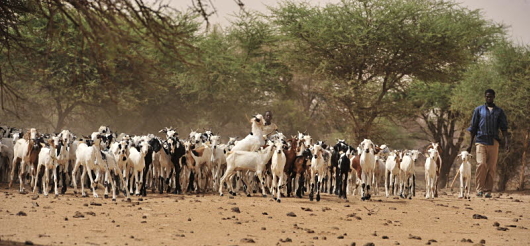Drylands are characterized by a scarcity of water, which affects both natural and managed ecosystems and constrains the production of livestock as well as crops, wood, forage and other plants and affects the delivery of many environmental services. The United Nations Environment Programme (UNEP) defines drylands according to an aridity index (AI), which is the ratio between average annual precipitation and potential evapotranspiration; drylands are lands with an AI of less than 0.65. UNEP’s classification system subdivides drylands on the basis of AI into hyper-arid lands, arid lands, semi-arid lands and dry subhumid lands. Drylands are found in most of the world’s biomes and climatic zones and constitute 41 percent of the global land area.

- The world’s drylands and subtypes. Prepared using spatial data from UNEP-WCMC (2007).
On the basis of satellite data, FAO has estimated that one-fifth of global forest cover is located in drylands. Forests covered about 13 percent of drylands in 2012, mostly in dry subhumid areas, but at least 3 percent of the world’s dryland forests were lost between 2000 and 2012. These figures do not include non-forest wooded lands and other tree-based systems, even though these play key roles in many dryland systems.
More than elsewhere, forests and agrosilvopastoral systems in drylands play crucial economic, social and environmental roles, including by improving the environmental sustainability and resilience of wider landscapes. Dryland forests and agrosilvopastoral systems harbour species that are particularly well adapted to extreme ecological conditions and provide essential goods and environmental services. If well managed and properly valued, dryland forest and woodland ecosystems can help alleviate poverty and contribute to the food security and sustainable livelihoods of 2 billion people worldwide. Dryland forests and agrosilvopastoral systems are important for the very poor, providing a source of food and other essential materials in periods of food insecurity, such as during dry seasons or in the wake of natural disasters and war. More generally, forests and trees in drylands are essential for sustaining rural livelihoods. In Africa, for example, 320 million people depend on dryland forests and woodlands to meet many of their basic needs, including medicinal supplies and woodfuel.
Dryland forests and agrosilvopastoral systems face serious threats, including degradation, fragmentation, deforestation and desertification. Various interrelated factors are driving these threats, such as climate change and climate-related disasters; policy and socioeconomic factors that lead to resource overharvesting; a lack of technical capacity; and a lack of understanding of the importance and vulnerability of dryland forest and woodland ecosystems.
Sustainable management of dryland forests and agrosilvopastoral systems
Sustainable management of dryland forests and agrosilvopastoral systems
The management and conservation of dryland forests and agrosilvopastoral systems often require different approaches to those suited to humid forests. The biodiversity of dryland forests and woodlands, and the physiological adaptations of species that allow their survival in dry conditions, are assets that should be identified, studied and used as tools to underpin sound management practices.
Many dryland forests and agrosilvopastoral systems are degraded or threatened by degradation, and management actions therefore often involve restoration (see the Forest Restoration and Rehabilitation module) aimed at reversing degradation processes and increasing the contributions of forests and associated landscapes to livelihoods, land productivity, environmental services and the resilience of human and natural systems. In dryland forests and other dryland ecosystems dominated by trees and shrubs, the re-establishment of trees and other species (such as grasses and shrubs) can restore protective and productive ecological functions. Integrated landscape-scale approaches to the restoration, protection and management of dryland forests and agrosilvopastoral systems have the greatest chance of success.





